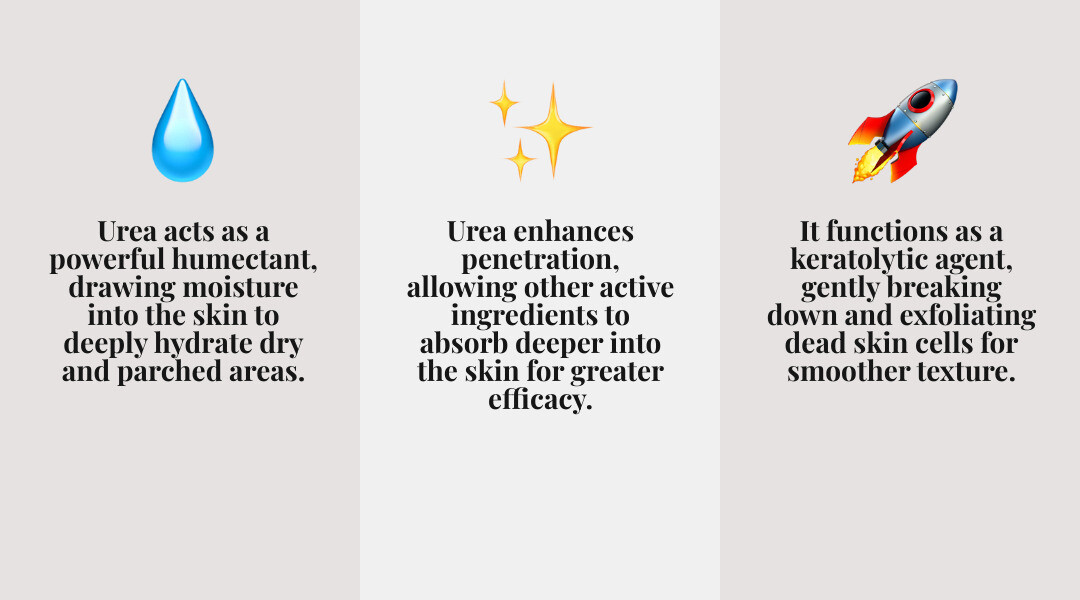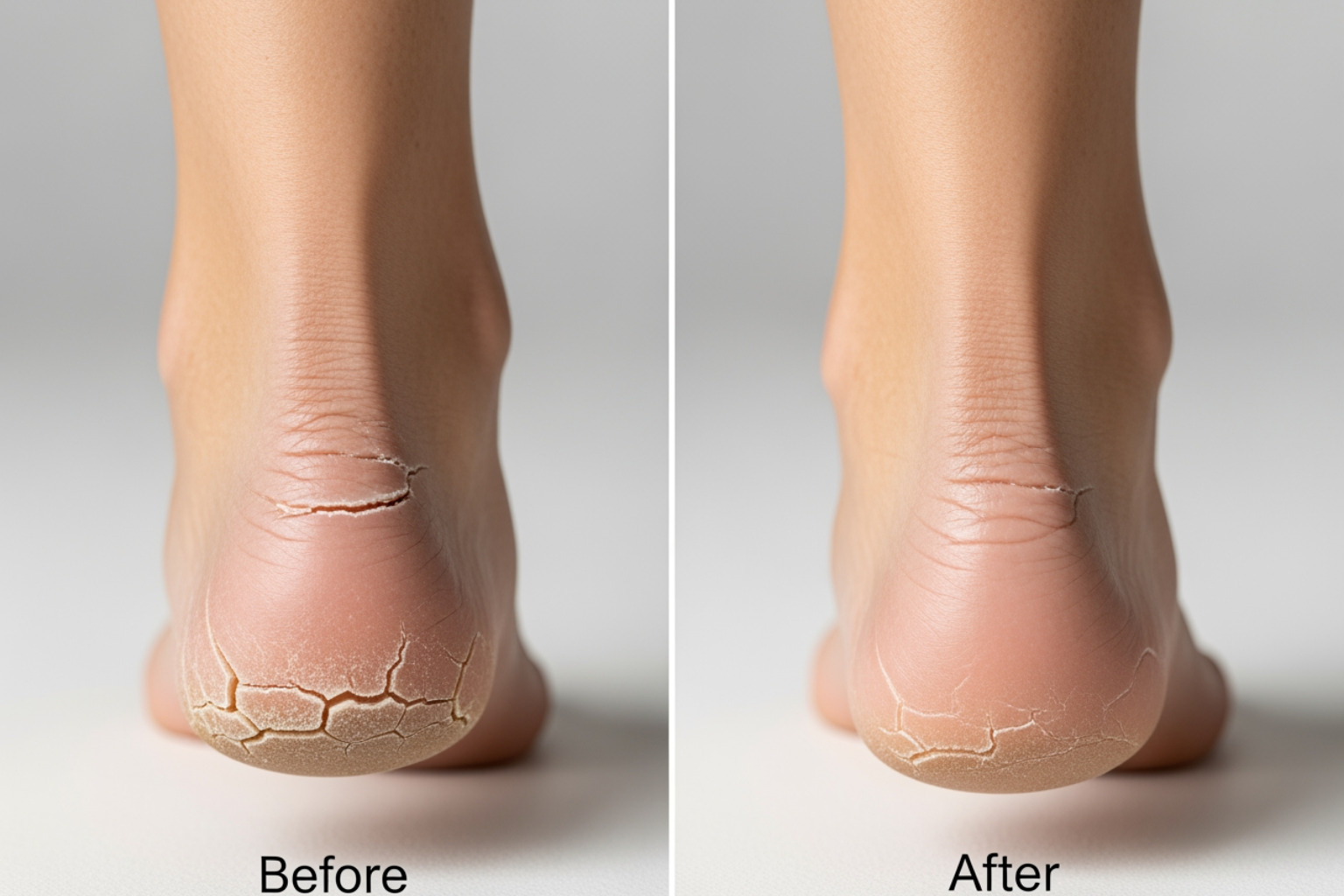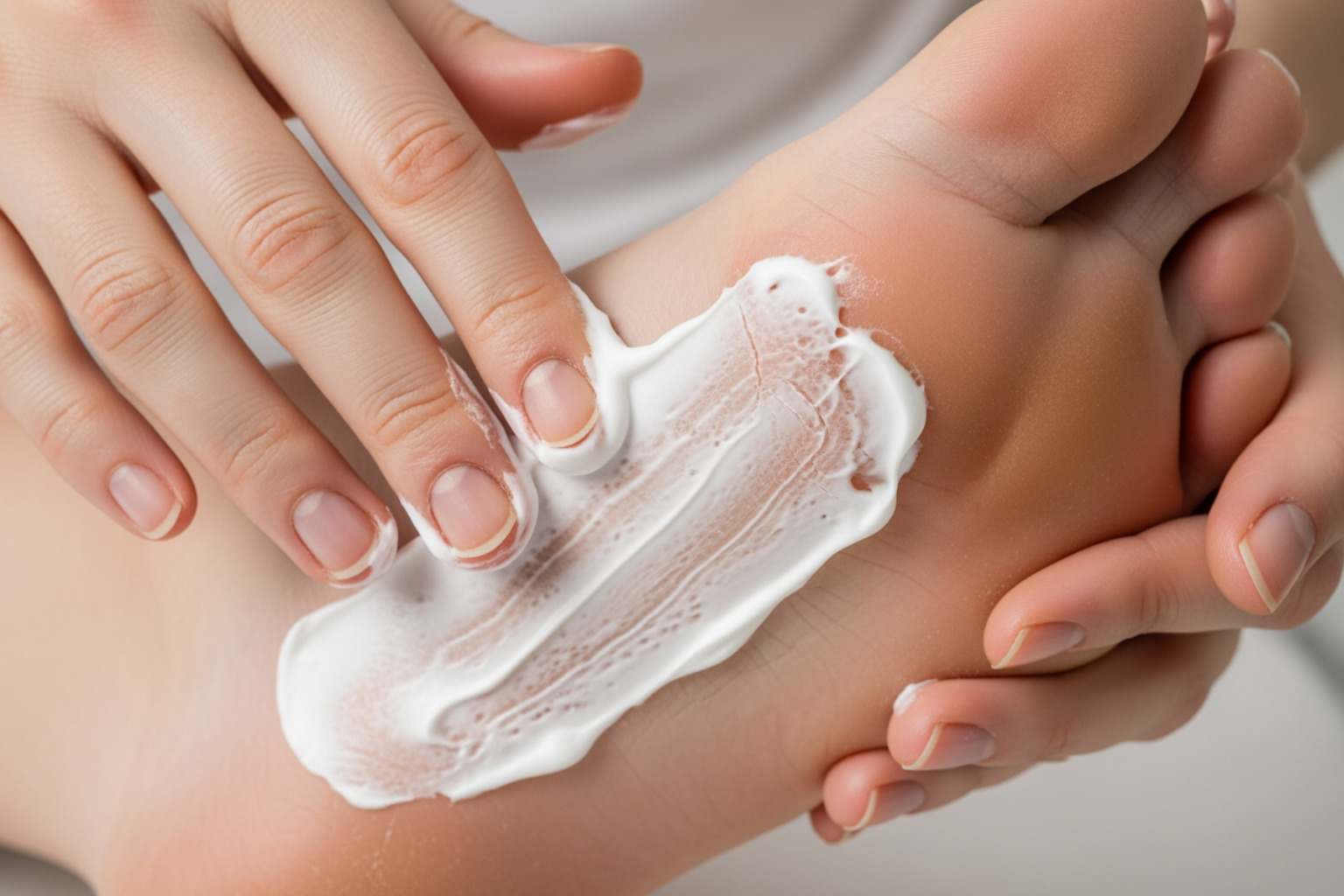Understanding Urea Cream: A Simple Guide to This Powerful Skin Care Ingredient
What is urea cream? Urea cream is a topical skincare product containing urea, an ingredient that works in two powerful ways: as a humectant to draw moisture into your skin, and as an exfoliant to gently break down dead skin cells. It's used to treat dry, rough, or thick skin from conditions like eczema, psoriasis, and calluses, and can also soften damaged nails.
Quick Facts About Urea Cream:
- What it is: A moisturizing and exfoliating cream with 2-40% urea.
- How it works: Acts as a humectant (hydrates) and a keratolytic agent (exfoliates).
- Common uses: Dry skin, eczema, psoriasis, calluses, cracked heels, and thick nails.
- Availability: Over-the-counter (lower strengths) and prescription (higher strengths).
- Safety: Generally safe, with mild, temporary side effects like stinging.
- Status: Listed on the WHO's List of Essential Medicines.
Beyond skincare, urea is a key ingredient in advanced topical treatments. It acts as a penetration improver, helping active ingredients in products like nerve pain relief cream or muscle pain relief cream absorb deeper for more effective relief. At Neuropasil, understanding what is urea cream and its delivery-enhancing properties has been essential to developing our pain relief formulas.

What is urea cream? terms to learn:
What is Urea Cream and How Does It Transform Your Skin?
You've likely seen "urea" or "carbamide" on an ingredient list and wondered, "What is urea cream actually doing?" This powerful ingredient is a skin transformer, and it's a natural part of your skin's own hydration system, known as the Natural Moisturizing Factor (NMF). The urea used in skincare is created synthetically in a lab, making it safe, pure, and effective.
Urea's secret is its dual-action mechanism, as detailed in topical skincare reviews. It works as both a humectant, drawing moisture into the skin, and a keratolytic agent, gently breaking down the bonds between dead skin cells. This unique combination is why it's so effective and why it's on the World Health Organization's List of Essential Medicines, a high honor for any ingredient.
How Urea Moisturizes and Exfoliates
As a humectant, urea acts like a moisture magnet. It pulls water from the air and deeper skin layers to the surface, plumping up skin cells and strengthening your skin's natural barrier. This provides deep, lasting hydration that breaks the cycle of dryness and irritation. This is the same principle that helps active ingredients in nerve pain relief cream penetrate deeper for better results.
As an exfoliant, urea's keratolytic action targets keratin, the protein that can build up and cause thick, scaly patches in conditions like psoriasis or severe dryness. By dissolving the "glue" holding dead cells together, urea promotes natural shedding, revealing smoother, healthier skin underneath. Unlike harsh scrubs, urea exfoliates gently, making it suitable for many skin types. This dual ability to moisturize while exfoliating is what makes urea a dermatologist's secret weapon for changing skin.
The Medical and Cosmetic Uses of Urea Cream
The versatility of urea cream is remarkable, tackling everything from diagnosed skin conditions to cosmetic concerns. So, what is urea cream good for? The list is extensive.

Treating Skin Conditions
For chronic dry skin conditions, urea cream can be life-changing. Its effectiveness is backed by extensive clinical reviews.
- Eczema (Atopic Dermatitis): Urea's hydrating and barrier-strengthening properties help calm the itch and restore moisture to inflamed patches.
- Psoriasis: Its keratolytic action softens and sheds the thick, scaly plaques, improving skin texture and appearance.
- Ichthyosis and Xerosis: For genetic or severe dryness, urea provides essential daily hydration and gentle exfoliation to manage symptoms and prevent painful cracking.
Softening Thickened Skin and Nails
Urea cream excels at targeting specific areas of hardened skin.
- Corns, Calluses, and Keratosis Pilaris: Higher concentrations of urea soften tough spots on feet and smooth the rough, bumpy patches of "chicken skin" on arms and legs by clearing keratin-plugged follicles.
- Nail Treatment: Urea softens thick, difficult-to-trim nails. It also plays a key supporting role in treating fungal nail infections by helping antifungal medications penetrate the nail plate more effectively, as confirmed by a 2019 systematic review.
Penetration Improver
Beyond treating skin directly, urea acts as a penetration improver, helping other active ingredients absorb more deeply. Your skin's outer layer is a barrier, but urea helps temporarily modify it, allowing medications to pass through more efficiently, as noted in a 2013 study on permeability enhancement.
This quality is crucial in Neuropasil's nerve pain relief cream and muscle pain relief cream. Urea acts as a key, allowing active ingredients like menthol and aloe to reach nerve endings and muscle tissues for faster, more targeted relief. It ensures the soothing compounds get to work where they're needed most, which is why our formula is effective for conditions from neuropathy to muscle soreness. You can learn more in our article, "The Science Behind Natural Formula with Aloe, Urea, and Menthol."
Finding Your Perfect Match: Urea Cream Concentrations Explained
Not all urea creams are the same. The percentage of urea determines its function, from a gentle daily moisturizer to a powerful treatment. Understanding these levels, which are based on clinical literature, is key to finding the right product for your needs.
| Urea Concentration | Primary Uses | Common Conditions Treated |
|---|---|---|
| Under 10% | Hydration, Barrier Support | General dry skin (xerosis), Daily moisturizing, Mild eczema |
| 10-20% | Hydration, Exfoliation | Keratosis pilaris, Cracked heels, Rough patches, Mild psoriasis |
| Over 20% | Intense Exfoliation, | Thick calluses, Severely thickened nails, Severe psoriasis, |
| Proteolytic Action | Non-surgical nail debridement, Ichthyosis (often prescription) |
Low Strength (Under 10% Urea)
Creams with under 10% urea are focused on hydration. They act as humectants to maintain a healthy skin barrier, making them perfect for daily moisturizing and managing general dry skin (xerosis). These are gentle enough for regular use on the face and body.
Medium Strength (10-20% Urea)
At 10-20% concentration, urea offers both significant hydration and noticeable exfoliation. This range is ideal for tackling conditions like keratosis pilaris ("chicken skin"), cracked heels, and rough elbows. Most over-the-counter creams for rough skin fall into this effective, dual-action category.
High Strength (Over 20% Urea)
Concentrations over 20% are intensive treatments. At this level, urea becomes a powerful proteolytic agent, meaning it actively breaks down proteins to remove damaged or dead tissue. These creams are used for severe conditions like thick calluses, damaged nails, and severe psoriasis, often under a doctor's guidance. While urea is a well-established ingredient, some high-concentration formulas may not have undergone the full FDA new drug approval process, so it's wise to consult a dermatologist before use, especially since they are often available by prescription.

Safe Application: Side Effects and Best Practices for Urea Cream
While generally safe, it's important to use urea cream correctly to get the best results and avoid discomfort. Most people tolerate it well, but some may experience temporary and mild side effects as their skin adjusts, such as stinging, burning, itching, or redness, especially on very dry or broken skin. These reactions, noted by sources like the Cleveland Clinic, usually fade with continued use.
When to See a Doctor
While rare, allergic reactions can occur. Seek immediate medical attention if you experience a widespread rash, hives, swelling (especially of the face or tongue), or difficulty breathing. You should also stop using the product and contact your doctor if you have severe or persistent irritation, burning, or blistering, as the concentration may be too strong for your skin.
Is urea cream safe for everyone?
For most adults, urea cream is safe for daily use, especially at lower concentrations. However, certain groups should take precautions, as advised by medical resources:
- Children: A child's skin is more delicate. Always consult a pediatrician before using urea cream on a child.
- Pregnancy and Breastfeeding: There is limited data on urea use during pregnancy. It's best to consult your healthcare provider before using it.
- Sensitive Skin: If you have sensitive skin or other conditions, a dermatologist can help you choose the right concentration and application schedule.
How to use urea cream effectively
Follow these tips for the best results:
- Apply to damp skin: For maximum hydration, apply the cream right after a shower or bath on towel-patted skin.
- Use a thin layer: A little goes a long way. Rub a thin, even layer into the affected area until fully absorbed.
- Avoid sensitive areas: Keep the cream away from your eyes, lips, and any broken or irritated skin to prevent stinging.
- Be consistent: Use the cream regularly, typically once or twice daily, as directed by the product label or your doctor.
- For feet: To treat cracked heels, apply the cream at night and wear cotton socks to bed. This helps the cream penetrate deeply. For more tips, see our guide: "Heal Your Heels: A Roundup of Healing, Natural, and Urea Foot Creams."
At Neuropasil, we use urea in our nerve pain relief cream to improve the delivery of active ingredients like menthol and aloe, ensuring they reach deep into tissues for fast, effective relief from pain and soreness.
Frequently Asked Questions about Urea Cream
When looking for the right solution for your skin or for pain relief, it's natural to have questions. Here are answers to some of the most common queries about what is urea cream.
What is the difference between urea cream and exfoliants like glycolic acid?
Both urea and glycolic acid exfoliate, but they work differently. Glycolic acid, an Alpha Hydroxy Acid (AHA), is a specialist that excels at dissolving the bonds between dead skin cells to resurface and brighten skin. However, it can sometimes be irritating for dry or sensitive skin.
Urea is a multitasker. While it also exfoliates by breaking down keratin, it simultaneously acts as a powerful humectant, drawing moisture into the skin and strengthening the skin barrier. This dual action of hydrating while exfoliating makes it a gentler and more balanced choice for skin that is both dry and rough.
Can I use urea cream with other skincare ingredients?
Yes, urea plays well with many other ingredients and can even boost their effectiveness. Pairing it with hyaluronic acid creates a hydration powerhouse. With salicylic acid, it provides comprehensive exfoliation for very rough skin. When used with ceramides, it helps repair and strengthen a compromised skin barrier, a synergy highlighted by skincare experts.
This synergistic principle is central to the Neuropasil formula. Urea acts as a penetration improver, helping active ingredients like menthol and aloe absorb more deeply to provide fast, targeted relief for nerve and muscle pain. Learn more in our article, "Discover the Power of All-Natural Relief."
Where can I find urea cream?
Urea cream is widely available in the United States. You can find it in drugstores, pharmacies, and online from various skincare retailers. Products are sold under many different brand names and are often found in sections for dry skin, foot care, or therapeutic skincare.
When choosing a product, the most important factor is the urea concentration. A low-percentage cream (e.g., 5-10%) is great for daily moisturizing, while higher-percentage formulas (20-40%) are designed for intensive treatment of calluses or severely thick skin. Always check the label to ensure the concentration matches your needs, and consider consulting a dermatologist for a personalized recommendation.
Conclusion: The Takeaway on Urea Cream
We've explored what is urea cream and finded it's a true skincare powerhouse. Its dual-action ability to both hydrate as a humectant and exfoliate as a keratolytic agent makes it an essential, science-backed solution for everything from everyday dryness to chronic conditions like eczema and psoriasis.
Beyond skincare, urea's most sophisticated role is as a penetration improver. By helping other active ingredients absorb more deeply, it improves the effectiveness of topical treatments.
This is why urea is a cornerstone of the Neuropasil formula. In our nerve pain relief cream and muscle pain relief cream, urea ensures that soothing ingredients like menthol and aloe don't just sit on the surface—they penetrate to where the pain originates, delivering fast, targeted relief for neuropathy, muscle soreness, and joint discomfort.
While choosing the right concentration is key, understanding how urea works empowers you to make better decisions for your skin health and pain management. It's a versatile ingredient proven to deliver results.
Ready to feel the difference a well-formulated topical cream can make? Explore our natural pain relief creams and find how smart ingredients like urea provide the targeted comfort you need.
References
Throughout this guide, we've drawn on extensive research and medical literature to bring you accurate, trustworthy information about urea cream. Understanding what is urea cream and how it works requires looking at the science behind this remarkable ingredient.
The foundation of urea's moisturizing properties is well-documented in dermatological research. Sethi A, Kaur T, Malhotra SK, and Gambhir ML provided an excellent overview of how moisturizers work in their 2016 study, "Moisturizers: The Slippery Road," published in the Indian Journal of Dermatology. This comprehensive review helped inform our discussion of urea's humectant properties.
For a thorough examination of urea's clinical applications, Pan M and colleagues conducted "Urea: a comprehensive review of the clinical literature," published in the Dermatology Online Journal in 2013. This review covered decades of research and clinical use, demonstrating urea's effectiveness across numerous skin conditions.
More recently, Celleno L published "Topical urea in skincare: A review" in Dermatologic Therapy in 2018, synthesizing modern understanding of urea's dual-action benefits and its role in contemporary skincare formulations.
The recognition of urea's importance in global healthcare is evidenced by its inclusion on the World Health Organization model list of essential medicines, published in 2019. This designation underscores urea's proven safety, efficacy, and accessibility for treating common skin conditions worldwide.
Understanding urea's role as a penetration improver was informed by research from Björklund S and colleagues, who published "Glycerol and urea can be used to increase skin permeability in reduced hydration conditions" in 2013. This study helped explain how urea helps other active ingredients penetrate the skin barrier more effectively—a principle we leverage at Neuropasil.
For information on urea's effectiveness in nail treatment, we referenced Dars S and colleagues' 2019 systematic review, "The use of urea for the treatment of onychomycosis," which demonstrated how urea improves antifungal treatment outcomes.
We also consulted several reliable medical and pharmaceutical resources for practical information about urea cream use, safety, and availability. These include Urea Topical on Drugs.com, the U.S. National Library of Medicine's DailyMed database, and the Cleveland Clinic's patient information on urea cream.
Additional consumer-friendly information about urea in skincare came from reputable sources including Medical News Today and CeraVe's ingredient information.
For specific product information and formulation details, we referenced various DailyMed entries for urea cream products, including 40% urea cream formulations and 20% urea cream options.
Background information on urea-containing creams was supplemented by the Wikipedia article on urea-containing cream and professional dosage information from Drugs.com.
All these sources contributed to creating a comprehensive, accurate, and practical guide to help you understand what is urea cream and how it can benefit your skin—or, in the case of Neuropasil's formulation, improve the delivery of pain-relieving ingredients for targeted relief.













